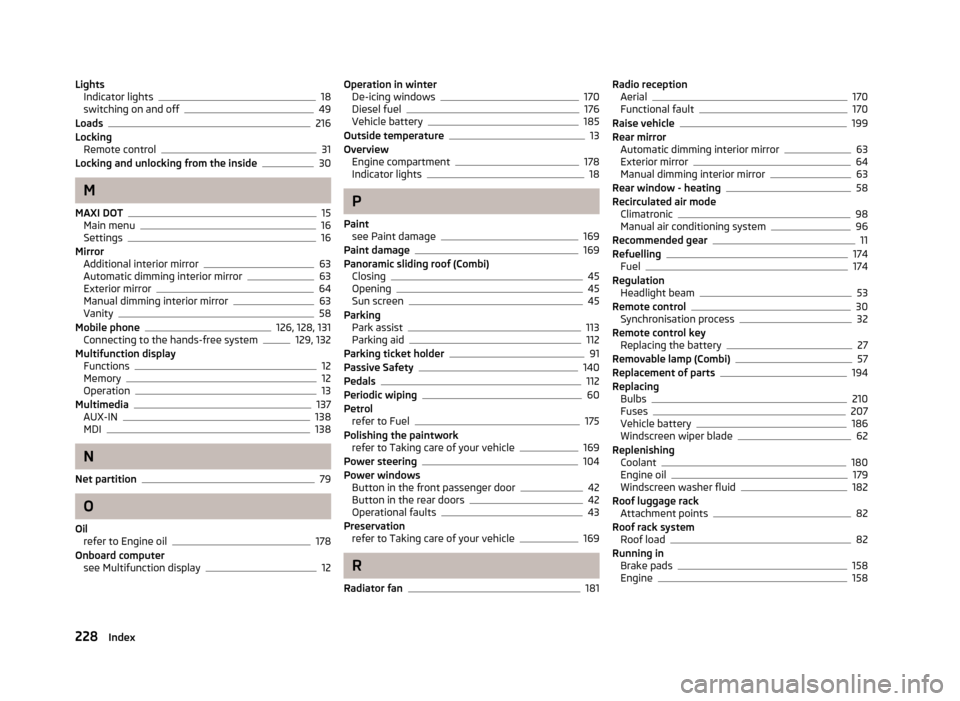brake pads replacement SKODA SUPERB 2012 2.G / (B6/3T) Owner's Manual
[x] Cancel search | Manufacturer: SKODA, Model Year: 2012, Model line: SUPERB, Model: SKODA SUPERB 2012 2.G / (B6/3T)Pages: 235, PDF Size: 5.86 MB
Page 111 of 235

CAUTION
■ Observe the recommendations on the new brake pads » page 158.
■ Never let the brakes slip with light pressure on the pedal if braking is not neces-
sary. This causes the brakes to overheat and can also result in a longer braking
distance and excessive wear. ■ All four wheels must be fitted with the same tyres approved by the manufactur-
er to ensure the brake assist systems operate correctly. Note
■ If the brakes are applied in full and the control unit for the braking system con-
siders the situation to be dangerous for the following traffic, the brake light
flashes automatically. After the speed was reduced below around 10 km/h or the
vehicle was stopped, the brake light stops flashing and the hazard warning light
system switches on. The hazard warning light system is switched off automatical-
ly after accelerating or driving off again. ■ Before negotiating a steep downhill section, reduce the speed, shift down into
the next lower gear (manual gearbox) or select a lower drive position (automatic
gearbox). As a result, the braking effect of the engine will be used, reducing the
load on the brakes. Any additional braking should be completed intermittently,
not continuously. ■ Changes to the vehicle (e.g. to the engine, brakes, chassis or another combina-
tion of tyres and wheels) can influence the functionality of the brake assist sys-
tems »
page 194 , Accessories, changes and replacement of parts .
■ If a fault occurs in the ABS system, the ESC, ASR and EDL also do not work. A
indicator light » page 23 comes on if a fault occurs in the ABS system. ÐInformation on braking
First read and observe the introductory information and safety warn-
ings on page 108.
Wear-and-tear
The wear of the brake pads is dependent on the operating conditions and driving
style. The brake pads wear more quickly if a lot of journeys are completed in
towns and over short distances or if a very sporty style of driving is adopted. If
operated under severe conditions, the thickness of the brake pads must be
checked by a ŠKODA specialist garage before the next service appointment. ä Wet roads or road salt
The performance of the brakes can be delayed as the brake discs and brake pads
may be moist or have a coating of ice or layer of salt on them in winter. The
brakes are cleaned and dried by applying the brakes several times.
Corrosion
Corrosion on the brake discs and dirt on the bake pads occur if the vehicle has
been parked for a long period and if you do not make much use of the braking
system. If the brake system is not used much or if there is corrosion on the sur-
face, we recommend cleaning the brake discs by firmly applying the brakes from a
fairly high speed.
Faults in the brake surface
If it is found that the braking distance has suddenly become longer and that the
brake pedal can be depressed further, the brake system may be faulty. Visit a
ŠKODA specialist garage immediately and adjust your style of driving appropriate-
ly as you will not know how great the damage is.
Low brake fluid level
An insufficient level of brake fluid may result in problems in the brake system. The
level of the brake fluid is monitored electronically » page 20, Brake system .
Brake booster
The brake booster increases the pressure generated with the brake pedal. The
brake booster only operates when the engine is running. Ð Handbrake
Fig. 116
Centre console: Handbrake
First read and observe the introductory information and safety warn-
ings on page 108.
Apply
›
Pull the handbrake lever firmly upwards.
£
ä
109
Starting-off and Driving
Page 230 of 235

Lights
Indicator lights 18
switching on and off 49
Loads 216
Locking Remote control 31
Locking and unlocking from the inside 30
M
MAXI DOT 15
Main menu 16
Settings 16
Mirror Additional interior mirror 63
Automatic dimming interior mirror 63
Exterior mirror 64
Manual dimming interior mirror 63
Vanity 58
Mobile phone 126, 128, 131
Connecting to the hands-free system 129, 132
Multifunction display Functions 12
Memory 12
Operation 13
Multimedia 137
AUX-IN 138
MDI 138
N
Net partition 79
O
Oil refer to Engine oil 178
Onboard computer see Multifunction display 12Operation in winter
De-icing windows 170
Diesel fuel 176
Vehicle battery 185
Outside temperature 13
Overview Engine compartment 178
Indicator lights 18
P
Paint see Paint damage 169
Paint damage 169
Panoramic sliding roof (Combi) Closing 45
Opening 45
Sun screen 45
Parking Park assist 113
Parking aid 112
Parking ticket holder 91
Passive Safety 140
Pedals 112
Periodic wiping 60
Petrol refer to Fuel 175
Polishing the paintwork refer to Taking care of your vehicle 169
Power steering 104
Power windows Button in the front passenger door 42
Button in the rear doors 42
Operational faults 43
Preservation refer to Taking care of your vehicle 169
R
Radiator fan 181Radio reception
Aerial 170
Functional fault 170
Raise vehicle 199
Rear mirror Automatic dimming interior mirror 63
Exterior mirror 64
Manual dimming interior mirror 63
Rear window - heating 58
Recirculated air mode Climatronic 98
Manual air conditioning system 96
Recommended gear 11
Refuelling 174
Fuel 174
Regulation Headlight beam 53
Remote control 30
Synchronisation process 32
Remote control key Replacing the battery 27
Removable lamp (Combi) 57
Replacement of parts 194
Replacing Bulbs 210
Fuses 207
Vehicle battery 186
Windscreen wiper blade 62
Replenishing Coolant 180
Engine oil 179
Windscreen washer fluid 182
Roof luggage rack Attachment points 82
Roof rack system Roof load 82
Running in Brake pads 158
Engine 158
228 Index